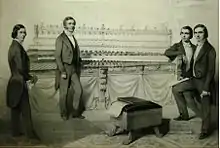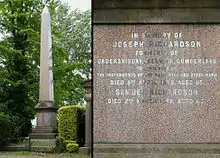Joseph Richardson (musician)
Joseph Richardson (c. 1790 – 8 April 1855) was an English stonemason and self-taught musician from Keswick, Cumbria, who was renowned in Victorian times after building an elaborate lithophone (the most famous of the Musical Stones of Skiddaw) with which he and his sons – performing as the 'Richardson & Sons, Rock, Bell and Steel Band' – toured the UK and Europe, giving numerous concerts, including one in London for Queen Victoria. [1]


He is buried in London, at the Kensal Green Cemetery.
Early life
A son of Daniel Richardson. His mother's name is unknown; she is reported as dying in Keswick on 29 February 1852 aged 83.[2]
Career
In January 1845 the band were on tour in Lincolnshire and the Isle of Ely, performing on 6th Town hall, Spalding; 8th Assembly rooms, Holbeach; 10th Bull Inn, Long Sutton and the Angles Theatre, Wisbech on 13th.[3][4]
By 1848 the instrument had expanded to include steel bars and bells.
ROCK AND STEEL BAND. Last evening, performance of a most interesting nature took place in Exeter Hall, for the purpose of testing the merits of a newly-discovered musical instrument, which has been designated "The rock and steel band".This instrument is of novel, though, at the same time, of simple construction. It consists of framework of wood, somewhat of the shape of a piano, the top of which is shelved off into four divisions, the lower division being about three feet broad ; the other three becoming gradually narrower, until the top one is circumscribed to about one foot broad. On the two lower shelves are placed a large number of bars, cut out of solid whinstone, and resembling thick bars of iron. These are taken from the Whinstone quarries in Skiddan, a wellknown mountain in Cumberland. The longest of them measure about three feet, and these are placed at one end of the frame, and serve as a bass, while they gradually diminish in length towards the other end of the frame, the shorter ones giving utterance to the more tender musical notes. the two upper shelves are placed pillars of polished steel, arranged in the same manner as are the stone bars below them, while above these are arranged 36 bells, the pieces of rock, steel, and bells, thus constituting a full band. The band is conducted by three performers, who strike the stones, the steel, and the bells with small wooden mallets, covered with pieces of soft leather, and which produces sounds of exquisite sweetness and melody. The programme of last evening consisted of selections from Rossini’s Opera, Guillaume Tell, Donizetti’s Operas, Parisina and Lucia di Lammemoor, Handel's Harmonious Blacksmith, with all the original variations, several duets by Callcott and others, the whole concluding with the National Anthem, performed in excellent style. The excellent manner in which the various pieces were executed elicited much applause from the audience, which was of private and select nature, consisting chiefly of parties connected with the musical world and their friends, and several of the pieces were encored. The rock and steel baud is the invention of Mr. Richardson ; and although to appearance its construction may be considered simple, yet we believe it has taken that gentleman thirteen years to bring it to the degree of perfection to which it has now attained. We have no doubt, however, but it will repay Mr. Richardson for the labour and thought he has thus expended upon it, as it would be difficult to find instrument now in use which can discuss music more eloquently.[5]
In January 1849 the band were to appear for Queen Victoria.
Richardson's Concert.—The beautiful performance of the Messrs. Richardson the celebrated Steel Band, Swiss Bells, and Rock Harmonican, will take place at the Athenaeum Room, in this town, on Monday next. It is impossible to attempt to describe the nature of the performances. But its effect is most surprising, whether in the sweet tones evoked from steel, stone, or bell, in Lucy Neal, Mary Blane, or the Evening Bells, or in the more bold and rapid execution of Cavatina, or Overture. The following notice appeared in the Times:—" We are glad that her Majesty has ordered the Messieurs. Richardson's Band to perform in her presence at Buckingham Palace ; it is an encouragement of talent, and we know of none who deserve it better than the inventors of the rock, bell and steel, band; it produces the richest harmony, full sweetness, and of the most delicate modulation, and will prove one of the most interesting and novel performances in the Metropolis." [6]
They also toured Ireland and were due to tour the United States and Canada, the death of one son caused these to be cancelled.
Under The Patronage Of The Queen. The following extraordinary and unrivalled combination of Musical Novelties will be introducd: THE STEEL BAND — The instruments of which are manufactured by Messieurs Richardson & Sons, and first Introduced by them into the Orchestras of the Grand Operas in Germany and Italy, possessing greater brilliancy, sweetness, and fullness of tone to those from any other material; also, THE SWISS BELLS — Arranged on an extensive scale, and introduced for the first time in this country at the Messieurs R’s Concerts in Exeter Hall, London, in June, 1848; since then, before the Imperial Court, at Petersburgh ; and are now the only description used on the Continent for the performance of Bell Music ; and THE ORIGINAL ROCK BAND greatly augmented ; and with the accessories of the Steel Instruments and the Swiss Bells combined, forms the most powerful and complete musical ensetnble, and which have been adjudged by the Artistes, the Amateurs, and the entire Press, to be the most extraordinary and perfect arrangement of Instruments for the performance of every class Music. Messieurs Richardson & Sons celebrated Band will give their last Orchestral Morning and Evening Concerts, previous to their departure for the United States and the Canadas, at the following places, when the Programmes will combine the same pieces of music as selected by command of her Majesty and performed at the Soirees Musicales at Buckingham Palace, on the 23rd of February, 1848 : Drogheda, ......Mayoralty Rooms,..Thursday, Aug. 14th. Dundalk,.......Market House, Friday, Aug. 16th, Newry,. ..Assembly Rooms... Monday, Aug. 18th. Downpatrick, ..Manor CourtRooms, Wednes., Aug. 20th, Newtownards,... Assembly Rooms,...Thursday, Aug. 21st. Belfast, ...Music Hall, ......Monday & Tuesday, Aug. 25th & 26th. Lisburn, ..Market House,. Wednesday., Aug. 27th. Banbridge,......Town Hall, ...Thursday, Aug. 28th. Armagh,... .Tontine Rooms, Friday, Aug. 29tb. Dungannon, Concert Rooms, Monday, Sept. Ist. Lurgan,.. Assembly Rooms,...Tuesday, Sept. 2d. The Morning Concert in each place will commence punctually at Half-past TWO o’Cloek. p.m. TICKETS, 2s. each ; Children and Schools, 1s. Evening Concerts at EIGHT o’Clock. Reserved Seats, 2s. ; Children and Schools, 1s.; Back Seats, 1s. Tickets, and full particulars in Programmes, to be had of the principal Booksellers, and at the Rooms in each Town.[7]
On Friday 18 January 1852 they played at Parsonston (now Birr, Ireland.[8] Following the concert one brother became ill.[9]
Later life
Death of Mr. Joseph Richardson.—We have to record the death of Mr. Joseph Richardson, the Inventor of the Instruments of the Rock, Bell, and Steel Band. The sad event took place at his residenoe, 134, Edgware Road, London, Sunday last, April the 8th, in the 66th year of his age. The surprising performances by the Inventor's three sons upon these unique instruments have, in all parts of the country, created the greatest degree of astonishment to all who have beheld their thrilling powers—Morning Advertiser, April 12th, 1855.[10]
Legacy
Recently the Richardsons' stones have gone on tour again.
A lakeside performance by Brian Dewan and Jamie Barnes was part of the Coniston Water Festival. A special frame and sound box was constructed to mount the stones for the performance. Dewan used 35 of the 60 slate notes for his composition. These notes corresponding to the white notes on a piano. The performance was also broadcast on radio.
This performance was repeated at the University of Leeds in May 2006; new music was performed and recorded as part as the Liverpool Biennial 2006. For these performances the Stones were joined by a Chinese classical orchestra, and the bells of Liverpool Cathedral.
In January 2006, the Musical Stones reached a large national audience when they were featured as part of a BBC Radio 4 documentary on Cumbrian musical stones presented by classical percussionist Evelyn Glennie. This documentary was entitled "The World's First Rock Band". In June 2006, the Stones were featured on National Public Radio across America.
Keswick Museum and Art Gallery were also involved with a three-year project set up by Yorkshire Quarry Arts based at the University of Leeds. It was an interdisciplinary project to find out why hornfels has musical properties, carry out historical research on the Cumbrian sets of musical stones and organise a series of performances. The Musical Stones of Skiddaw were played in several events for Yorkshire Quarry Arts.
In 2007 and 2008, Keswick Museum and Art Gallery collaborated with the music charity Soundwave and Changeling Productions to produce a theatrical performance entitled 'The Musical Stonemason - A Cumbrian Wayang'. This show told the story of how the Musical Stones were discovered by Peter Crosthwaite and made famous by Joseph Richardson. The show was performed at the Royal Festival Hall, London and The Sage Gateshead in 2007 as well as several shows across Cumbria in 2008.
In 2017, a series of 'Monster Solid Rock Lithophone Concerts' by Gordon Pickering took place.[11]
References
- "The Musical Stones of Skiddaw". Allerdale Borough Council. Archived from the original on 19 June 2010. Retrieved 16 Jul 2014.
- Carlisle Journal. 5 March 1852. p. 3. Missing or empty
|title=(help) - "Richardsons' Rock Concerts". Lincolnshire Chronicle. 3 January 1845. p. 3.
- "The Rock Harmonicon". Cambridge General Advertiser. 15 January 1845. p. 3.
- "Rock and Steel Band". Morning Advertiser. 15 June 1848. p. 3.
- "Richardson's Concert". Derby Mercury. 3 January 1849. p. 3.
- "Under the patronage of the queen". Newry Telegraph. 16 August 1851. p. 1.
- "The Rock and Steel Band". Kings County Chronicle. 14 January 1852. p. 2.
- "Richardson and sons". Kings County Chronicle. 21 January 1852. p. 3.
- "Death". Dublin Evening Mail. 18 April 1855. p. 3.
- "Monster Solid Rock Lithophone Concerts". www.keswickmuseum.org.uk. Retrieved 3 December 2020.